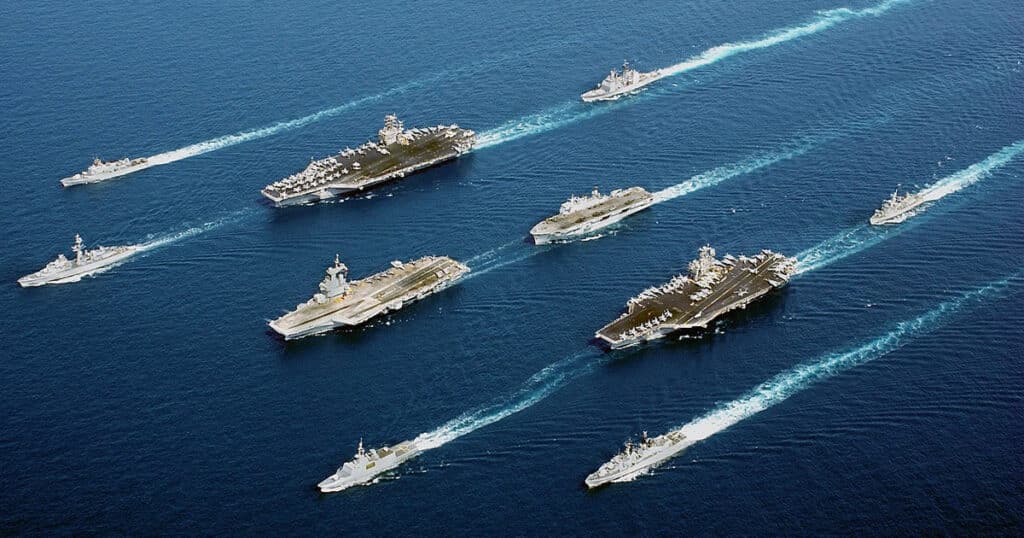
Revitalizing Shipbuilding by Expanding Warship Orders
The big, beautiful reconciliation bill passed by the House and now with the Senate, includes $150 billion in defense spending. This is an outstanding opportunity to gain escape velocity from normal defense budget processes and buy and build above what we would have otherwise.
In defense circles, the shipbuilding portion of this bill has garnered significant attention since President Trump made it clear that revitalizing shipbuilding and the Navy is one of his biggest national-security priorities. The reconciliation bill does a respectable job funding auxiliary ships and amphibious warfare ships, both of which are critical. It also funds, at an extremely high level, potentially promising but operationally untested unmanned surface vessels.
However, for the manned warships that will be doing the warfighting for the foreseeable future, the reconciliation bill funds only two destroyers, one submarine, and zero frigates. If the goal is to expand the size of the U.S. Navy’s surface fleet and make it more lethal, a third destroyer, a second submarine, or a couple frigates with at least one at a new second shipyard, really ought to also be funded through the reconciliation process as well.
Unfortunately, it seems likely that some of these ship orders will not be in addition to the ones Congress would have bought anyway in the next couple National Defense Authorization Acts, and that Congress may use these ship orders as an excuse to fund other projects in the regular defense budget. If this ends up being the case, the total number of warships in the U.S. Navy will not grow, and the stagnation will continue.
Opponents of dramatic increases in procurement orders will say that industry is not yet ready to handle these orders. They’ll say that there will be delays, and that the government should first invest in expanding infrastructure at the shipyards and getting the current shipbuilding backlog cleared before buying any more ships.
This does not deal with the reality of shipbuilding and how it is financed. Backlogs and predictable orders are the foundation on which infrastructure and workforce investments are planned and made. As such, it would make a lot more sense to simply buy larger numbers of warships in bulk to send a massive demand signal to industry and incentivize shipbuilders to pay for infrastructure and labor on their own (and block buys often reduce costs overall).
Private-sector companies build American warships and operate America’s shipyards. These companies are perfectly capable of attracting capital to invest in infrastructure and labor when they have a steady demand signal incentivizing them to do so.
The strategy of focusing on paying for infrastructure and not buying many more ships than would have been funded anyway ignores basic economic principles. If followed, it will result in a Navy about the same size, more likely smaller, as the one we have now well into the 2030s.
Of course, new ship orders, which do send a strong demand signal, could also be funded through the Fiscal Year 2026 National Defense Authorization Act (and they should be). Unfortunately, recent history has shown that this will be a difficult battle, as the procurement of warships tends to be more controversial than, say, the ever-expanding list of white papers and centers of excellence in the research and development budget.
Every year for the last few years, the congressional authorization and appropriations committees have had months-long, often heated debates about how many ships to order. The end result is usually that a ship or two gets cut (at best, the minimum is maintained), and the Navy either stays the same size or shrinks—and critical infrastructure investments and workforce growth is further deferred.
For that reason, supporters of President Trump’s shipbuilding goals should look to get as many new warships funded through reconciliation or some other novel method like a naval act with a separate block buy of ships. At a certain point, if you want more ships you have to buy more ships, and it may be a very long time before Congress again has the opportunity that reconciliation offers to revitalize the American shipbuilding industry and expand the number of warships in the U.S. Navy.
Wilson Beaver is a Senior Policy Advisor for defense budgeting at The Heritage Foundation.
This article was originally published by RealClearDefense and made available via RealClearWire.



